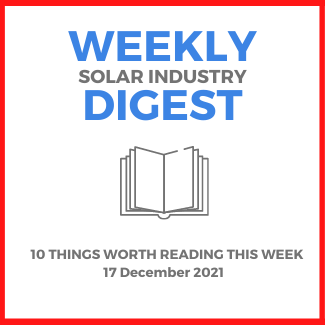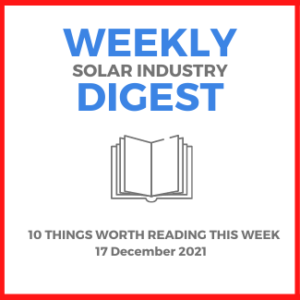Q3 2021 showed incredible growth in storage. The market pushed past 1 GW of installations for the first time, almost more than what was installed in all of 2020: 1,140MW / 3,515MWh of energy storage was installed in the US. Most activity was in front-of-the-meter, utility-scale and most was in CA. There was also growth in res and non-res installs.
Solar design and sales platform company OpenSolar and financier for res solar and energy-efficient home improvements Mosaic are partnering up to “build efficiencies into the solar sales process.” They aim to streamline solar applications and financing options as part of the project proposal process to shorten the time it takes to convert prospects.
The House of Reps unanimously voted to pass the Uyghur Forced Labor Prevention Act that bans all imports from Xinjiang, China. Exceptions would apply if suppliers can prove products were not made with forced labor. It also passed the Senate this week, and Biden is intimating he will sign it. It means “guilty until proven innocent” and lasts up to 8 years.
CA’s Build Energy Efficiency Standards now require solar power and batteries in all future commercial structures and multifamily homes. It also mandates new res construction has to be energy storage ready (in addition to the current rule about being solar ready). Estimates say this new development would tack on 280 MW of annual solar capacity and 400 MWh of energy storage.
In another timely article roundup, Aurora dives into net metering. The articles include why NEM matter so much and has become so contentious, how virtual net metering works and is a possible growth market, a case study of Utah’s NEM regarding impact on installers, and assessing the impact of MI’s 2019 DTE net metering replacement policy.
Mitrex Integrated Solar Tech now has solar roof panels that are traditionally sized but with customizable a tempered glass overlay that is able to mimic specific roof design. Options are designs that mimic black asphalt and black slate. There’s also an anti-soiling coating to shave down on dust and dirt accumulation. The panels are similar in size to 72-cell panels.
Shell is solidifying its bid to reach net-zero emissions by 2050 by purchasing large utility-scale and C&I solar and energy storage developer Savion LLC. Savion has 18 GW+ of solar power and battery storage under development. Shell’s end game is to double their current capacity for electricity generation to get up to 560 TWHR globally annually by 2030.
WoodMac projects that 2022 US solar capacity will lower by 7.4 GW down to 22.2 GW given rising costs due to supply chain and logistical challenges – representing a 25% dip. The passage of Build Back Better could mean a 44 GW increase in capacity through 2026.
EnergySage offers a handy resource for your prospects (and you if needed) regarding peak demand and ways to reduce it. The not-too-lengthy article discusses electricity 101, defines peak demand and its relationship to the grid and utility woes and needs, and the role of solar and energy storage in fielding peak demand impact.
A new report on climate tech funding and deals shows that investment climbed in the second half of 2020 and the first half of 2021 to $87.5 billion. However, there’s a lot of areas of untapped potential: the top 5 of the 15 tech areas studied that make up 80% of future emissions reduction potential by 2050 only got 25% of investment in the past 10 years.


